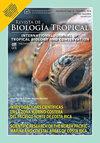受威胁珊瑚颈角Acropora cervicornis (sclactinia, Acroporidae)对珊瑚火虫的人口学和种群反应
IF 0.6
4区 生物学
Q4 BIOLOGY
引用次数: 1
摘要
简介:火虫Hermodice carunculata是一种广泛分布的多毛纲动物,可以捕食许多珊瑚物种。然而,很少有研究调查了在非爆发期间,萤火虫捕食对珊瑚人口统计的影响。目的:研究弓形虫的捕食是否会影响濒危珊瑚鹿角珊瑚的生长、生存和种群表现。方法:将苗圃饲养的珊瑚碎片(n = 99)固定在波多黎各库莱布拉岛市Punta Melones礁的底部。从2020年12月到2022年8月,对珊瑚外植体的捕食活动及其人口影响进行了评估。比较了直接从珊瑚礁收集的种群和从外部来源(如珊瑚苗圃)收集的种群对捕食的敏感性。利用人口统计数据,建立了简单的基于大小的种群矩阵模型,以1)检验萤火虫捕食是否导致种群增长率显著下降(λ), 2)确定对λ贡献最大的人口转变(s),以及3)在只考虑前殖民地或同时考虑前和非前外植体的情况下,确定导致λ差异的人口转变(s)。结果:随着时间的推移,捕食增加,在地形起伏最大的地区和研究地点以外的殖民地更频繁地观察到。部分被消耗的外植体比未被消耗的外植体生长得慢得多;然而,捕食并没有威胁到它们的生存。被fireworm攻击的可能性随着分支复杂性的增加而增加。在只考虑那些有前期菌落的情况下,λ的估计值为0.99,而在同时考虑有前期菌落和无前期菌落的情况下,λ的估计值为0.91。在这两种情况下,人口增长主要受大型群体存活并保持最大规模的可能性的影响。结论:虽然捕食会对珊瑚生长产生负面影响,但相对较高的存活率弥补了不利影响。由于生存是对种群增长贡献最大的人口转变,因此可以得出结论,在非爆发情景下,萤火虫的捕食可能不是颈喙拟蚊种群下降的主要原因。本文章由计算机程序翻译,如有差异,请以英文原文为准。
Demographic and population response of the threatened coral Acropora cervicornis (Scleractinia, Acroporidae) to fireworm corallivory
Introduction: The fireworm Hermodice carunculata is a widespread polychaete that can prey upon many coral species. However, few studies have examined the effect of fireworm predation on coral demographics during non-outbreak periods.
Objective: To determine whether predation by H. carunculata compromised the growth, survival, and population performance of the threatened coral Acropora cervicornis.
Methods: Nursery-reared coral fragments (n = 99) were fixed to the bottom of Punta Melones reef in the Island Municipality of Culebra, Puerto Rico. Predation activity and its demographic consequences on coral outplants were assessed from December 2020 to August 2022. Susceptibility to predation was compared between colonies collected directly from the reef and those originating from outside sources (e.g., coral nurseries). With the demographic data, simple size-based population matrix models were developed to 1) examine whether fireworm predation led to a significant decline in population growth rate (λ), 2) determine the demographic transition(s) that contribute the most to λ, and 3) determining the demographic transition(s) that accounted for differences in λ when comparing scenarios that considered either only predated colonies or both predated and non-predated outplants.
Results: Predation increased over time, being more frequently observed in the area with the highest topographic relief and on colonies foreign to the study site. Outplants that were partially consumed grew significantly slower than non-predated colonies; however, predation did not threaten their survival. The likelihood of being attacked by the fireworm increased with branching complexity. The estimated λ for a scenario considering only those predated colonies was 0.99, whereas, for a scenario where both predated and non-predated colonies were considered, λ was 0.91. Population growth, under both scenarios, was mainly influenced by the probability of a large colony surviving and remaining at the largest size.
Conclusions: Although predation can negatively impact coral growth, the relatively high survival rate of predated colonies compensates for the adverse effects. Since survival is the demographic transition that contributes most to population growth, it could be concluded that under a non-outbreak scenario, fireworm predation may not be the primary cause of A. cervicornis population decline.
求助全文
通过发布文献求助,成功后即可免费获取论文全文。
去求助
来源期刊

Revista De Biologia Tropical
生物-生物学
CiteScore
1.80
自引率
0.00%
发文量
23
审稿时长
4-8 weeks
期刊介绍:
The Revista de Biología Tropical / International Journal of Tropical Biology and Conservation is a mainstream scientific journal published since 1953 and covered by Web of Science; Science Citation Index; Current Contents; Google Scholar; Scopus, SciELO and nearly 50 additional indices.
A double blind system guarantees you a fair evaluation, and our world class editorial and scientific boards provides a first decision in three working days. The journal is Full Open Access and is widely read where your article can have the highest real impact.
Since its beginning in 1953, the Revista follows these principles: objective and independent evaluation of all manuscripts; transparency in all processes; ethical use of procedures, data, specimens and subjects; fair treatment of all parties; and absolute predominance of scientific rigor over any other aspect.
 求助内容:
求助内容: 应助结果提醒方式:
应助结果提醒方式:


